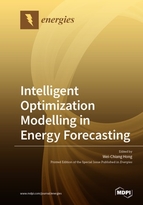Intelligent Optimization Modelling in Energy Forecasting
A special issue of Energies (ISSN 1996-1073). This special issue belongs to the section "C: Energy Economics and Policy".
Deadline for manuscript submissions: closed (31 December 2019) | Viewed by 40742
Special Issue Editor
Interests: short-term load forecasting; intelligent forecasting technologies (e.g., neural networks, knowledge–based expert systems, fuzzy inference systems, evolutionary computation, etc.); hybrid forecasting models (e.g., hybridizing traditional models with intelligent technologies, or hybridizing two or more different models to form a novel forecasting model); novel intelligent methodologies (chaos theory; cloud theory; quantum theory)
Special Issues, Collections and Topics in MDPI journals
Special Issue Information
Dear Colleagues,
Accurate energy forecasting is important to facilitate the decision-making process in order to achieve higher efficiency and reliability in power system operation and security, economic energy use, contingency scheduling, the planning and maintenance of energy supply systems, and so on. In the past decades, many energy forecasting models have been continuously proposed to improve the forecasting accuracy, including traditional statistical models (e.g., ARIMA, SARIMA, ARMAX, multi-variate regression, exponential smoothing models, Kalman filtering, Bayesian estimation models, etc.) and artificial intelligence models (e.g., artificial neural networks (ANNs), knowledge-based expert systems, evolutionary computation models, support vector regression, etc.).
Recently, due to the great development of optimization modelling methods (e.g., quadratic programming method, differential empirical mode method, evolutionary algorithms, meta-heuristic algorithms, etc.) and intelligent computing mechanisms (e.g., quantum computing, chaotic mapping, cloud mapping, seasonal mechanism, etc.), many novel hybrid models or models combined with the above-mentioned intelligent-optimization-based models have also been proposed to achieve satisfactory forecasting accuracy levels. It is worthwhile to explore the tendency and development of intelligent-optimization-based modelling methodologies and to enrich their practical performances, particularly for marine renewable energy forecasting.
All submissions should be based on the rigorous motivation of the mentioned approaches, and all the developed models should also have a corresponding theoretically sound framework. Works lacking such a scientific approach are discouraged. Validation support of existing/presented approaches is encouraged to be done using real practical applications.
Prof. Dr. Wei-Chiang HongGuest Editor
Manuscript Submission Information
Manuscripts should be submitted online at www.mdpi.com by registering and logging in to this website. Once you are registered, click here to go to the submission form. Manuscripts can be submitted until the deadline. All submissions that pass pre-check are peer-reviewed. Accepted papers will be published continuously in the journal (as soon as accepted) and will be listed together on the special issue website. Research articles, review articles as well as short communications are invited. For planned papers, a title and short abstract (about 100 words) can be sent to the Editorial Office for announcement on this website.
Submitted manuscripts should not have been published previously, nor be under consideration for publication elsewhere (except conference proceedings papers). All manuscripts are thoroughly refereed through a single-blind peer-review process. A guide for authors and other relevant information for submission of manuscripts is available on the Instructions for Authors page. Energies is an international peer-reviewed open access semimonthly journal published by MDPI.
Please visit the Instructions for Authors page before submitting a manuscript. The Article Processing Charge (APC) for publication in this open access journal is 2600 CHF (Swiss Francs). Submitted papers should be well formatted and use good English. Authors may use MDPI's English editing service prior to publication or during author revisions.
Keywords
- statistical forecasting models (ARIMA, SARIMA, ARMAX, multi-variate regression, Kalman filter, exponential smoothing, etc.)
- artificial neural network (ANNs) models
- knowledge-based expert system models
- fuzzy theory and fuzzy inference system models
- evolutionary computation models
- support vector regression (SVR) models
- hybrid models
- combined models
- evolutionary algorithms
- meta-heuristic algorithms
- seasonal mechanisms (single seasonal mechanism
- multiple seasonal mechanism)
- intelligent computing mechanisms (chaotic mapping mechanism
- quantum computing mechanism
- cloud mapping mechanism)
- marine renewable energy forecasting
- electric load forecasting
- energy forecasting.






